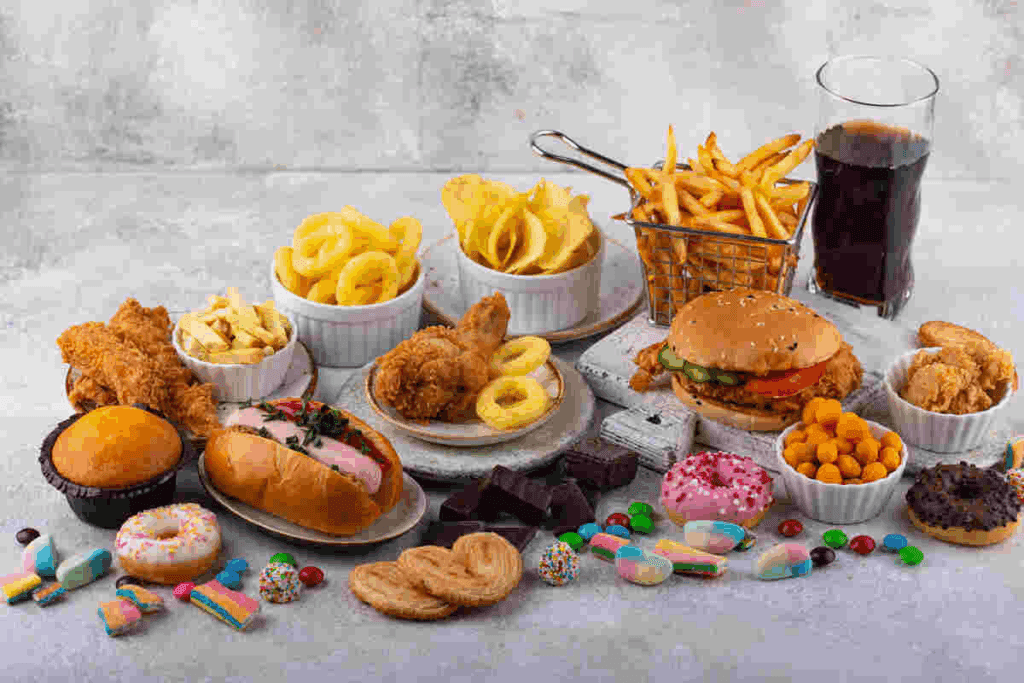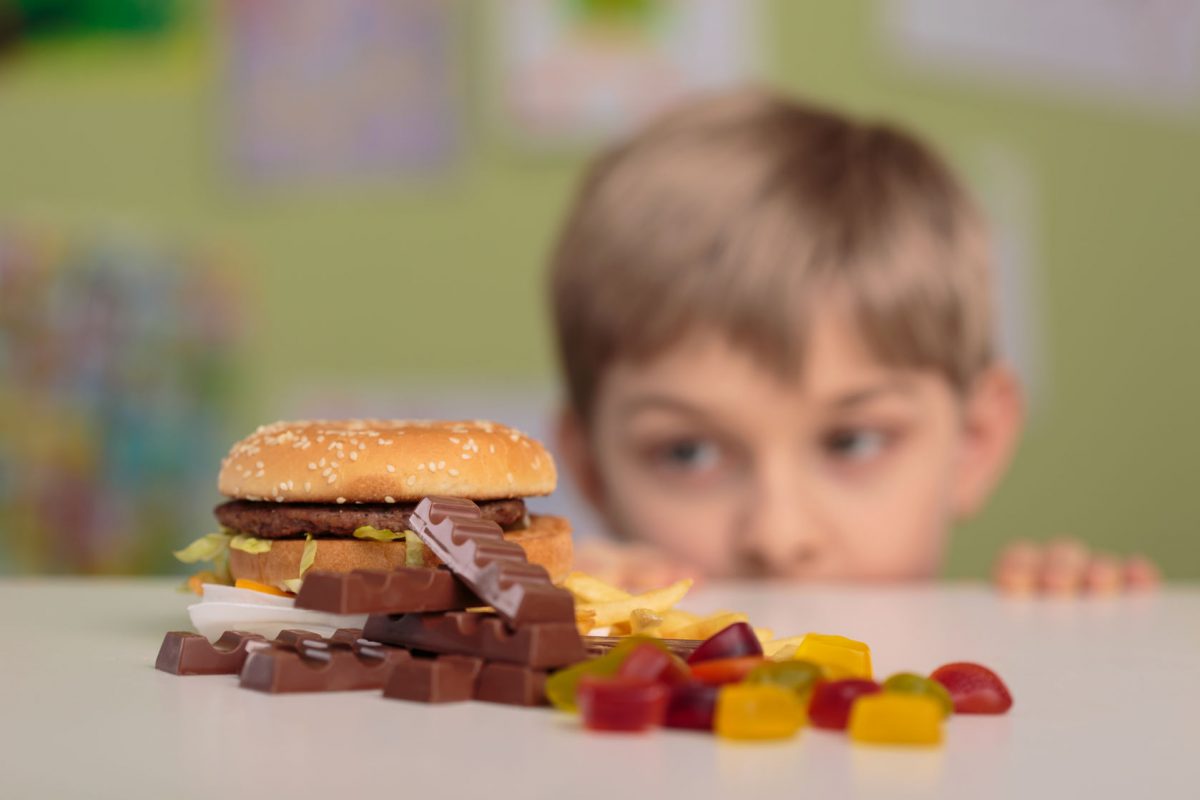Last Updated on November 24, 2025 by
Childhood obesity is a big problem worldwide. 1 in 10 children aged 5 to 19 live with obesity, says UNICEF. This number has tripled from 2000, showing we need to act fast. Knowing how ultra-processed foods affect kids is very important.

Ultra-processed foods are a big reason for kids’ obesity. As doctors, we know how vital it is to help parents choose better for their kids. By talking about the risks of unhealthy foods, we can help kids eat better.
Childhood obesity is a big problem worldwide. It affects kids’ health and well-being. The numbers show we need to act fast.

Childhood obesity is a huge issue. Around the world, 188 million kids are obese. This is a serious problem for their health and future.
The World Health Organization is warning us. They say we need to change how kids eat and move. This includes avoiding very unhealthy foods and unhealthiest foods to eat.
Childhood obesity has grown fast. Rates have tripled from 2000 to now. This shows we’re failing to help kids eat right.
A report by The Guardian highlights junk food’s harm. It’s a big reason for the obesity rise.
Childhood obesity leads to serious health problems. Kids can get type-2 diabetes, heart disease, and cancer. It also affects their mental health, causing low self-esteem and depression.
We need to tackle childhood obesity in many ways. This includes teaching kids, changing laws, and working together. By doing this, we can help kids stay healthy and avoid long-term health issues.
Ultra-processed foods are everywhere in today’s diets. They can harm children’s health if we don’t know how to handle them. These foods are bad for health and can change how kids eat.
Ultra-processed foods have lots of sugar, unhealthy fats, salt, and chemicals. They’re made from processed parts of whole foods. Examples include packaged snacks, sugary cereals, and ready-to-eat meals. They last a long time and are easy to grab for busy families.

Look out for added sugars, refined starches, and unhealthy fats in these foods. They add a lot of calories but no nutrients. Also, many have artificial flavorings, colorings, and preservatives that can harm health.
Ultra-processed foods are made to attract kids. They have colourful packaging and fun ads that kids love. The sugar and salt make them taste great, making kids want more. Plus, they’re easy for parents to grab when they’re in a hurry.
Parents need to understand why kids like these foods. Knowing the ingredients and marketing tricks helps parents choose better for their families.
Fast food is a big problem for kids’ health all over the world. It’s tasty and easy to get, but it’s not good for them. This is why it’s a big worry.
Burgers, nuggets, and fried foods are full of calories, fats, and sodium. They are often fried in oils that are bad for the heart. Just one meal can give a kid too many calories and fats.
A study found that kids who eat fast food a lot are more likely to be overweight or obese. This is because fast food has lots of empty calories, added sugars, and bad fats. These can make kids gain weight and have health issues.
Many parents don’t know how many calories and fats are in fast food. For example, a big serving of fries has over 500 calories and 25 grams of fat. A cheeseburger can have over 700 calories and 30 grams of fat. These hidden calories can quickly add up, contributing to weight gain and obesity.
“The high calorie and fat content in fast food can lead to a lifetime of health problems, including obesity, diabetes, and heart disease.”
Fast food is also very high in sodium, which is bad for kids’ health. Too much sodium can raise blood pressure and heart disease risk. Children who eat a lot of high-sodium foods are more likely to get these problems early.
To help kids stay healthy, parents can do a few things. They can eat fast food less often, choose healthier options when they can, and teach kids about eating well.
By knowing what’s in fast food and making smart choices, we can keep kids healthy. We can also teach them to eat better.
Sugary drinks and treats are bad for kids’ health. They can cause many problems. We must teach parents about these dangers to help their kids eat better.
Sodas and sugary drinks add a lot of sugar to kids’ diets. Drinking them often can lead to too many calories. This can cause obesity and other health issues. Many foods and drinks seem healthy but are actually full of sugar.
A single can of soda has up to 40 grams of sugar. This is more than kids should have in a day. We need to watch out for hidden sugars in these drinks.
Candy, chocolate, and desserts are full of sugar and unhealthy fats. They often have artificial additives, too. These treats have few nutrients but lots of empty calories.
Children who eat these often start to like sweet tastes more. This makes it hard for them to eat a balanced diet. We should suggest healthier options for sweet cravings.
The sugar in these drinks and treats harms teeth, causing cavities and tooth decay. It also makes energy levels go up and then down. This can affect kids’ focus and energy.
Drinking a lot of sugary drinks raises the risk of type-2 diabetes. This disease is becoming more common in kids because of their diet and lack of exercise.
We need to teach parents and kids about the dangers of sugary foods and drinks. This can help prevent type-2 diabetes and encourage healthier living.
Processed snacks and convenience foods are key areas to focus on when looking at unhealthy foods for kids. These foods are tasty and easy to grab, but are missing important nutrients. This makes them a big worry for kids’ health.
Chips, crackers, and other packaged snacks are common in kids’ diets. But they are full of unhealthy fats, sodium, and artificial additives. These ingredients lead to too many calories and push out healthier foods from kids’ diets.
Processed snacks often have chemicals to make them taste better and last longer. Artificial colours, flavours, and preservatives like sodium benzoate can harm kids’ health. They might cause hyperactivity and other behaviour problems.
The biggest problem with processed snacks is that they have no real nutritional value. They give energy but no vitamins, minerals, or fibre. Eating these snacks often can cause nutritional gaps and health issues like obesity.
To help kids eat better, parents and caregivers need to know what’s in the snacks they give them. Choosing whole, nutrient-dense foods like fruits, veggies, and whole grains is key. When picking packaged snacks, always check the labels to avoid bad additives and preservatives.
Food marketing’s effect on kids’ eating habits is a big worry worldwide. Kids see lots of ads for unhealthy foods. This can change what they like to eat and their health.
Research shows kids see a lot of food ads. 75% of teens see ads for sugary drinks, snacks, or fast food every week. This can make them want to eat these foods more.
Food ads are everywhere. Kids are bombarded with messages to eat unhealthy foods.
Food ads use tricks to grab kids’ attention. They use cartoon characters, toys, and special offers to make unhealthy foods seem good. This makes kids like these foods more.
These tricks make kids want these foods. They might ask their parents for them more often.
Ads for unhealthy foods can shape kids’ food choices. Kids might start to like foods high in sugar, salt, and unhealthy fats. This can lead to bad eating habits that last a long time.
Many countries are trying to stop unhealthy food ads to kids. Some ban junk food ads during kids’ TV shows. Others limit the use of characters on unhealthy foods and require nutrition labels on food packages.
By understanding how food marketing affects kids and making rules, we can help kids eat healthier.
The morning meal is often seen as the most important. But, many popular breakfast options are actually unhealthy. It’s key to know the nutritional traps in common breakfast foods.
Many breakfast cereals for kids are full of sugar and lack nutrients. Some brands have up to 11 grams of sugar per serving, almost the daily limit for kids. These cereals are marketed with bright colours and cartoon characters, making them seem appealing but not healthy.
Breakfast pastries and toaster items, like muffins and croissants, are made with refined flour and sugars. They are high in empty calories and unhealthy fats. Eating these foods often can cause a quick rise in blood sugar, followed by a drop, leaving kids tired and hungry soon after.
Even foods labelled as “healthy” can have hidden sugars. Flavoured yogurts and some granolas have added sugars that up their calorie count without adding nutrition. Parents should always check labels to spot these hidden sugars.
There are healthier breakfast options that give kids the nutrients they need. Choices like oatmeal with fruit, scrambled eggs with veggies, and whole-grain toast with avocado are both nutritious and tasty. By choosing wisely, parents can teach their kids to eat well for life.
Knowing the unhealthy parts of common breakfast foods and choosing better options can help kids start their day right.
Unhealthy foods are a big risk for kids’ health, leading to more obesity and health problems later. Parents are key in teaching kids to eat better by choosing the right foods.
Knowing which unhealthiest foods and most unhealthy foods to avoid is important. This includes foods like ultra-processed snacks, sugary drinks, and processed foods. Parents can help kids stay away from these by promoting healthier eating habits.
By giving kids healthy food options and limiting unhealthy ones, we guide them to make better choices. This helps them develop good eating habits that will last a lifetime.
Unhealthy foods for kids include burgers, nuggets, sugary cereals, and processed snacks. These foods are full of calories, added sugars, sodium, and unhealthy fats. They lack essential nutrients.
Food marketing shapes kids’ food choices. Ads use fun characters and offers to make unhealthy foods appealing. This can make kids prefer unhealthy foods over healthy ones.
Better choices than fast food are grilled chicken or fish, baked veggies, and whole-grain sandwiches. Parents can cook healthy meals at home with fresh ingredients. Getting kids involved in cooking helps too.
Sugary drinks and treats cause a quick energy spike followed by a crash. They increase the risk of type 2 diabetes, obesity, and dental problems.
Parents can spot unhealthy foods by checking ingredient lists and nutrition labels. Look for added sugars, sodium, and unhealthy fats. Limiting these involves setting rules, promoting healthy eating, and providing nutritious options.
Good breakfast choices are oatmeal with fruits and nuts, scrambled eggs with whole-grain toast, and Greek yogurt with berries. These provide nutrients, fibre, and protein for energy.
Parents can make smart choices by understanding food nutrition, knowing marketing tricks, and eating healthily themselves.
Ultra-processed foods are heavily processed and contain added sugars, sodium, and unhealthy fats. They are a concern because they are high in empty calories and low in nutrients. Regular consumption can lead to health issues.
Parents can encourage healthy eating by providing a balanced diet, limiting unhealthy foods, and encouraging new fruits and veggies. Getting kids involved in meal planning and cooking helps, too.
Vallianou, N. G., et al. (2025). Ultra-Processed Foods and Childhood Obesity. Nutrition Reviews, 83(1), 45-61. https://pubmed.ncbi.nlm.nih.gov/39753987/
Chen, Z. H., et al. (2025). Ultraprocessed Food Consumption and Obesity Development in Canadian Children: A Cohort Study. JAMA Network Open, 8(1), e2256234. https://jamanetwork.com/journals/jamanetworkopen/fullarticle/2829780Dicken, S. J., et al. (2025). Ultraprocessed or Minimally Processed Diets Following Childhood Obesity: Association in Jordanian Children. Nature Medicine. https://www.nature.com/articles/s41591-025-03842-0
Subscribe to our e-newsletter to stay informed about the latest innovations in the world of health and exclusive offers!